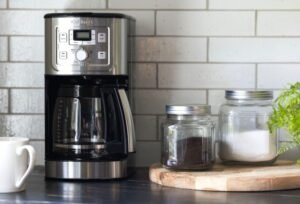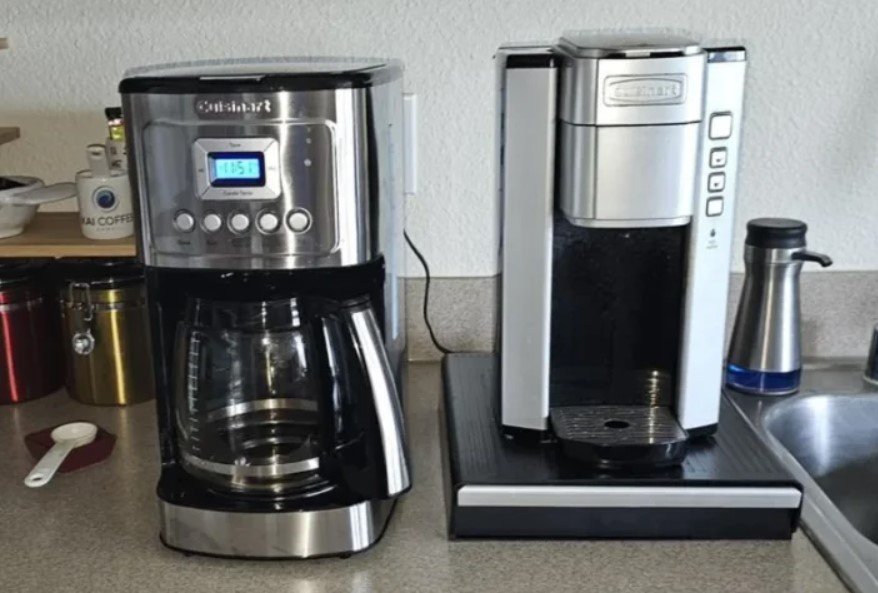There’s nothing quite like that first cup of coffee in the morning, right? But if you’re noticing your Cuisinart 14-cup coffee maker isn’t brewing quite like it used to, or if your coffee tastes a little off, it might be time for a cleaning. Just like any other machine that regularly deals with water, coffee makers can build up mineral deposits, coffee oils, and even mold if neglected. Luckily, cleaning your Cuisinart coffee maker is easy, and I’m going to walk you through it, step by step.
No need to panic, no need for a complex chemistry set – just a few common household items and a little bit of elbow grease. So, grab your cleaning supplies and let’s get started!
Why You Need to Clean Your Coffee Maker Regularly
You wouldn’t go weeks without washing your favorite coffee mug, right? (Well, I hope not!). The same rule applies to your coffee maker. The oils from coffee beans, hard water minerals, and residue can accumulate inside the machine. This affects the taste of your coffee and could even cause your machine to malfunction.
Let’s look at a few good reasons why you should keep your Cuisinart coffee maker sparkling clean:
- Better tasting coffee: Residue and mineral build-up can make your coffee taste bitter.
- Longer machine life: Regular cleaning helps prevent clogs and mechanical issues.
- Health benefits: Bacteria and mold can grow in a dirty coffee maker, especially in warm, moist environments.
- Energy efficiency: A clean machine heats up more effectively, making your brewing process smoother and faster.
Now that we’re clear on the why, let’s dive into the how!

Step-by-Step Guide: Cleaning Your Cuisinart Coffee Maker 14-Cup
Cleaning your coffee maker can be broken down into two main parts: routine cleaning and deep cleaning. Each plays an important role in keeping your machine in tip-top shape.
Materials You’ll Need
- Warm, soapy water
- White vinegar
- Clean, dry cloth or paper towels
- A small brush or toothbrush
- Fresh water
1. Regular Cleaning (For Daily/Weekly Maintenance)
A little bit of routine cleaning goes a long way! Here’s what you should be doing on a regular basis to keep your Cuisinart 14-cup coffee maker running smoothly.
a. Cleaning the Carafe and Lid
First things first, let’s take care of the obvious – the carafe. Your coffee pot is likely the most used part of your coffee maker, and it should be cleaned after every use.
- Wash the carafe and its lid with warm, soapy water. Make sure to rinse it thoroughly to remove any soap residue that could affect the taste of your coffee.
- For stubborn coffee stains, you can use a mixture of baking soda and water to scrub the inside of the carafe.
b. Cleaning the Filter Basket and Reservoir
Now, take out the filter basket and any paper filters or grounds. The basket and reservoir area can collect a lot of grime.
- Wash the filter basket with soapy water and a sponge. You may need to use a small brush to reach any crevices.
- Wipe down the inside of the reservoir with a damp cloth. This will remove any leftover coffee grounds or oils that might have splashed up there.
c. Wipe Down the Exterior
The exterior of your machine can also get pretty grimy from coffee spills and fingerprints. Simply wipe it down with a damp cloth, making sure to pay attention to the buttons and display area. A clean machine looks nicer and is easier to use!
2. Deep Cleaning (For Descaling and Heavy Maintenance)
Regular cleaning is great, but over time, mineral deposits from your water will build up inside the machine. This is especially true if you live in an area with hard water. Deep cleaning, or descaling, is essential for removing this build-up and ensuring your coffee maker brews properly.
a. How to Descale Your Coffee Maker Using Vinegar
Descaling might sound intimidating, but it’s super simple. You’ll just need some white vinegar and water.
Steps to Descale:
- Empty your coffee maker: Make sure there are no coffee grounds or filters in the basket.
- Mix your vinegar solution: Combine equal parts white vinegar and water. For your 14-cup Cuisinart, you’ll want to fill the water reservoir with about 7 cups of vinegar and 7 cups of water.
- Start a brew cycle: Run the coffee maker as if you’re making a regular pot of coffee, but without any coffee grounds.
- Pause midway: When about halfway through the brewing cycle, turn off the machine and let the solution sit in the coffee maker for 30 to 60 minutes. This gives the vinegar time to break down the mineral deposits.
- Complete the cycle: After letting it sit, turn the machine back on and allow it to finish the brewing cycle.
- Rinse: To get rid of the vinegar smell and taste, you’ll need to run two full cycles of fresh water through the machine.
b. Cleaning the Heating Plate
The heating plate is what keeps your coffee warm after it’s brewed. Over time, spills and drips can cause it to get sticky and burnt. No one wants to smell burnt coffee!
- Make sure the plate is cool before cleaning it. Wipe it down with a damp cloth and a little mild detergent if necessary.
- For tough, burnt-on stains, you can use a mixture of water and baking soda. Just be gentle to avoid damaging the surface of the plate.
Tips for Keeping Your Coffee Maker in Top Shape
To avoid frequent deep cleans and ensure your machine runs smoothly, here are a few extra tips:
- Use filtered water: Hard water leaves mineral deposits that can build up over time. Using filtered or bottled water can reduce this.
- Empty the carafe immediately: Don’t let coffee sit in the pot for hours, especially if the heating plate is on. Not only will your coffee taste burnt, but the residue will bake onto the pot.
- Replace the charcoal water filter: Cuisinart coffee makers often come with a charcoal water filter to remove impurities from water. Check your manual for how often it needs to be changed.
- Don’t overfill the water reservoir: Adding too much water can cause spills and make a mess. Stick to the recommended level.
Common Problems and Troubleshooting
Even with regular cleaning, things can occasionally go wrong. Here are some common issues you might run into and how to fix them:
- Coffee Tastes Bitter
If your coffee has a bitter or sour taste, it could be a sign of oil or mineral build-up inside the machine. Time to run a vinegar cleaning cycle!
- Coffee Maker is Brewing Slowly
A slow brew is usually due to mineral deposits clogging the system. Descaling will help get things moving again.
- Machine Won’t Turn On
If your machine refuses to turn on, check to make sure it’s plugged in (hey, it happens to the best of us!). If it still doesn’t work, there could be a mechanical issue. In that case, you may need to contact Cuisinart for support.
Conclusion: How to Clean Cuisinart Coffee Maker 14-cup
Keeping your Cuisinart coffee maker clean doesn’t have to be a huge chore. With a little regular maintenance and the occasional deep clean, you’ll enjoy better-tasting coffee and a machine that lasts longer. And let’s be real, when your coffee maker is happy, you’re happy. It’s a win-win!
So, take some time out this weekend to give your coffee maker a little TLC. Your taste buds will thank you!
To Read More Articles Visit- XYZ Web Toons
